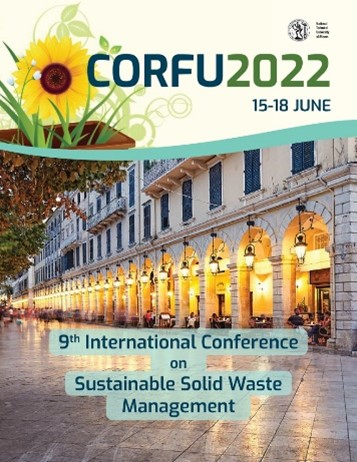9th International Conference on Sustainable Solid Waste Management Corfu, Greece, 15 – 18 JUNE 2022
Objective:
The Conference aims to address the significant issue of sustainable solid waste management through the promotion of safe practices & effective technologies. The Conference focuses mainly on modern solid waste technologies. It aims to stimulate the interest of scientists and citizens and inform them about the latest developments in the field of municipal solid waste management.
More information
BlackCycle consortium with CSIC propose an abstract at CORFU 2022
Scaling-up of waste tyre pyrolysis process from TRL-5 up to TRL-7 using an auger reactor technology – 16th June, 2022 at 1:30pm by A. Veses, A. Sanchis, J. Daniel Martinez, J. Manuel Lopez, T. Garcia, R. Murillo
Recovering value-added hydrocarbons from pyrolysis of end-of-life tires:
fractioning the derived oil in a pilot scale distillation plant
Juan Daniel Martínez, Alberto Veses, Alberto Sanchís, José Manuel López, Tomás García, Ramón Murillo
Instituto de Carboquímica (ICB-CSIC), Miguel Luesma Castán 4, 50018, Zaragoza, Spain
Corresponding author: jdmartinez@icb.csic.es
Abstract
Tire pyrolysis oil (TPO) is one of the most valuable products derived in pyrolysis of end-of-life tires (ELT) and entails an important content of renewable energy given the natural rubber in tires. This hydrocarbon not only offers a remarkable heating value but also an important source of valuable chemical products such as benzene, toluene, ethylbenzene and xylene (BTEX), as well as limonene, among others. In order to recover these chemical compounds, a pilot scale distillation plant has been designed, erected and operated using TPO from an industrial-scale pyrolyzer. The distillation plant consists in a single-packed column (20 kg/h) and is within the fifth technological readiness level (TRL5). This work describes for first time the fractioning of the TPO in a continuous fashion under industrially relevant conditions. For this purpose, different reboiler temperatures (250–290 ºC) and reflux ratios (up to 2.4) were preliminary assessed on the yields and characteristics of the resulting products: light fraction (LF) and heavy fraction (HF). In all cases, the temperature profiles along the distillation column decrease from the bottom to the upper part of column, and were found to be very stable over the operation time without any signs of instabilities. The distillation plant is capable to produce 27-35 wt% and 65-73 wt% of LF and HF, respectively. The highest BTEX concentration in the LF (62.54 wt%) was found using a reboiler temperature of 250 ºC and a reflux ratio of 2.4. Contrary, the highest limonene concentration (4.9 wt%) in the LF was obtained at 290 ºC without reflux. In this sense, the lower the reboiler temperature, the higher the BTEX, and the lower the limonene concentration in the LF. The simulated distillation curve of the HF suggests the presence of very heavy hydrocarbons compounds (boiling points from 139.0 ºC to 519.1 ºC), intended to be used as feedstock for carbon black production. The main results herein obtained serve to confirm not only the minimum number of equilibrium stages but also the height equivalent to a theoretical plate (HETP). In addition, it provides key information for the next steps of technological development.
Keywords: pyrolysis, end-of-life tires, distillation, tire pyrolysis oil, BTEX
